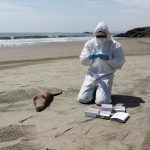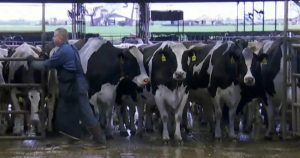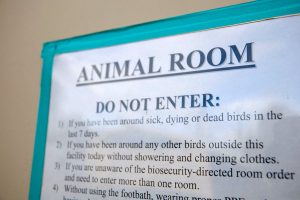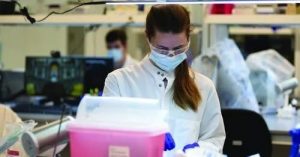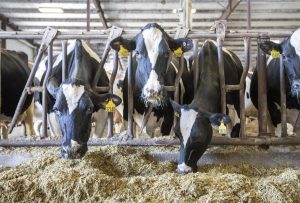
The H5N1 crisis at dairy farms shows that public health agencies have failed to absorb the lessons of Covid.
The bird flu outbreak at US dairy farms keeps finding alarming new ways to surprise scientists. Last week, the US Department of Agriculture confirmed that H5N1 is spreading not just from birds to herds, but among cows. Meanwhile, media reports suggest an unknown number of cows are asymptomatic. Although the risk to humans is still low, it’s clear that far more work needs to be done to get a handle on the reach of the virus and how it is being transmitted.
That will require the USDA and the Centers for Disease Control and Prevention to get out of their own way. There’s a palpable frustration among infectious disease experts that the agencies are being too protective of critical information and too timid in surveilling the virus. For example, so far, testing has been limited and until yesterday, only a handful of viral sequences had been publicly shared.
This is frankly infuriating, particularly coming on the heels of the Covid pandemic. Did public health agencies learn nothing from their mistakes during that searing experience?
The USDA’s approach to sharing information illustrates part of the problem. Last week, the agency came out with its first public admission of cow-to-cow and cow-to-poultry transmission. Those key nuggets weren’t shared in a press release, but rather were buried in the “FAQ” document. In other words, the USDA isn’t exactly keeping secrets, but it also isn’t exactly highlighting important developments. That approach counters everything we learned during Covid.
There could be serious consequences to the agencies’ lack of transparency and data-hoarding. Without clear information from public health experts, people start to fill in the blanks themselves. In an age of rampant misinformation and disinformation on social media, conspiracy theorists are happy to take advantage of any perceived knowledge gaps.
To turn things around, the USDA and CDC can start by vastly improving data sharing, beginning with the genetic sequences of viral samples. Samples taken from animals can offer answers to the many questions about how they are getting infected. And changes in the genome can be a red flag; we need to know as quickly as possible if mutations are popping up that increase the virus’s ability to infect humans. But the government spent weeks keeping this genomic information close to the vest. Until yesterday, they’d only published a handful of genomes out of over 200 they’d collected.
Bird Flu Has Spread to Cows Across the US
Why the delay? This isn’t 1994, it’s 2024. We can now rapidly and cheaply sequence genomes. We have the resources to share that information with experts around the world. The difference between days and weeks matters during an outbreak, so let’s hope the USDA doesn’t again drag its heels with any future samples. “Given the gravity of the situation, any data they get should be immediately distributed to the public so that we can have some of the best geneticists, virologists and epidemiologists try to understand it,” says Michael Mina, an epidemiologist and expert on infectious disease outbreaks, who spoke with me before the government had shared more genomic data.
Next on the checklist is more testing — and more incentives for farmers to test not only their cattle, but other livestock and workers. Because H5N1 has made occasional appearances over the last decade, we already have tests that can detect the virus as well as evidence of a past infection. But according to a New York Times report, until a few days ago the USDA was only paying for farmers to test a maximum of 20 sick cows.
The USDA told the Times that it would start covering tests for asymptomatic cows, but that is too little, too late. Given the evidence of asymptomatic infections and cow-to-poultry transmission, why are we not casting a wider net to catch any signs that the virus is finding its way into other animals, whether livestock or wildlife? As for human testing, the single human known to be infected in this outbreak had only mild symptoms. That means it would be easy for other infected humans to go undetected. So why is the CDC maintaining that asymptomatic people do not need to be tested?
“With any new infection that’s spreading, whether in humans or in animals, the best approach is to have the light switch to go full on — as opposed to a dimmer — in terms of increasing our surveillance efforts,” says Andrew Pekosz, a professor of molecular microbiology and immunology at Johns Hopkins Bloomberg School of Public Health.
Government agencies’ cautious approach to surveillance is particularly mind-boggling given that the US just spent four years building up a robust testing infrastructure. This isn’t to suggest the kind of widespread testing deployed during peak Covid is needed, but certainly there are many fast and cheap ways to get a better sense of what’s going on at farms, such as pooling samples or monitoring wastewater.
Another information vacuum that needs filling: Does the pasteurization process destroy the virus in milk? Every livestock and infectious disease expert I’ve spoken with in the last month believes it should, but with the new twist of asymptomatic cows (that are apparently producing milk as normal), that assumption urgently needs to be backed by data that can assure the public our food supply is safe.
Conducting those studies takes time, but “it’s been three weeks since we knew we needed this data,” and it needs to be shared faster, says Michael Osterholm, director of the Center for Infectious Disease Research and Policy in Minnesota.
Osterholm did have some comforting thoughts on the possibility that milk from asymptomatic cows could accidentally make its way to grocery store shelves. He noted that pasteurization lowers the levels of any pathogenic material to minute levels, and if any lingering H5N1 made it into the milk system after that process, it would be diluted when combined with milk from healthy cows. In other words, any exposure would be vanishingly small and well below the level needed to infect someone.
But the problem is that even when there’s nothing “sinister or unprofessional” at work, “when you don’t share the data, it leads people to believe there’s something else going on,” he cautioned.
Getting such details out quickly isn’t just about understanding the outbreak in the US. The international community is watching and worrying about their own farms. That evokes another lesson from Covid: When one country refuses to share information early on in an outbreak, the whole world is put at greater risk.
Let’s hope the coming weeks bring a more sensible approach from US agencies. The job of the USDA, CDC and Food and Drug Administration isn’t only to wrangle the virus, but also to manage the messaging. And so far in this H5N1 outbreak, they are doing a poor job of both. We’ve seen this movie before. As Covid taught us, once lost, the public’s confidence is very difficult to regain.
You can now read the most important #news on #eDairyNews #Whatsapp channels!!!
🇺🇸 eDairy News INGLÊS: https://whatsapp.com/channel/0029VaKsjzGDTkJyIN6hcP1K


